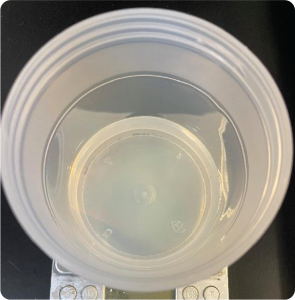

With the ever-increasing demand for high performance lithium-ion batteries used in Electric Vehicles (EVs), solar power storage, consumer electronics and more, the testing, optimization and quality control of materials during the battery manufacturing process is more critical than ever.
One of the most critical components that determines battery quality is the battery slurry, a complex suspension made by mixing an active material like graphite with a binder powder, solvents and additives. The slurry is then applied to multiple layers if aluminum foil and copper film to create the battery cell.
Proper slurry mixing is an essential part of producing a high quality battery, but can present many challenges. One, lithium-ion battery slurries are viscous, containing raw materials that must be precisely deagglomerated. The mixing process must also be highly repeatable to ensure optimal product performance.
First introduced to the R&D industry almost 50 years ago by Hauschild Engineering, the legendary Hauschild SpeedMixer® DAC mixer has become an indispensable part of R&D, QA and manufacturing across many industries around the world.
In battery manufacturing, DAC mixers are shortening the development, analysis and quality assurance process by a wide margin.
According to Ian LaRose, VP of Technology at Hauschild Engineering, the DAC mixer’s increasing popularity in lithium-ion battery manufacturing comes down to three factors: control, speed, and clean up.
“If materials aren’t thoroughly mixed in a battery slurry, the dry ingredients will remain agglomerated and performance will suffer,” says Ian. “Hauschild SpeedMixer® offers very fine control of mixing speed and time, delivering the exact level of dispersion desired.”
High shear mixing is often necessary to fully disperse the ingredients. However, overmixing or overshearing can cause suboptimal performance of the finished product. Having a thorough knowledge of the materials is important, as well as using accurate & precise processing equipment to achieve the best results repeatably.
“Hauschild SpeedMixer® has many knobs to turn in regards to higher or lower shear,” says Ian. “It’s also fully programmable, so once the optimal mix is dialed in, it’s reproducible.”
Speed is another factor that sets a centrifuge mixer apart from conventional mixers in the slurry process. Binders and film forming materials used in battery formulations can require a long time to dissolve. Using a Hauschild SpeedMixer® turns what can be an hours-long mixing process into ten minutes or less.
The secret is the dual asymmetrical centrifuge mixing process. The dual rotation of centrifugal forces acting in different planes creates a highly efficient mixing process that delivers homogeneous results. DAC mixers also achieve almost 100% degassing during the mixing process. This is especially important when mixing battery slurries, because any bubbles present will pop during the coating process, leading to small pinholes in the coating. These pinholes can result in lower performance or even failure of the device.
“The beautiful thing about DAC mixing is that it naturally pulls the bubbles out,” says Ian. “In the rare case that you need to remove even the smallest microbubbles, Hauschild SpeedMixer® with vacuum technology is available.”
The final factor making DAC mixers desirable in battery slurry production is the quick and easy clean-up process. Using conventional mixing equipment, clean up can be difficult, time consuming and even harmful.
Small particles and film-forming polymers make thorough cleaning of conventional slurry mixing equipment difficult at best. Even if the cleaning is done properly, the technician is likely to be exposed to cleaning chemicals that could be harmful with continued use.
“DAC mixers like Hauschild SpeedMixer® use disposable cups, making cleanup nonexistent,” says Ian. “All the risks of exposure to cleaning solvents go away, and all the time a technician didn’t have to spend cleaning is regained.”
Another advantage of using a DAC mixer that uses disposable cups in varying sizes is batch control. There is no minimum batch size, so technicians can make exactly what is needed per the application.
“Hauschild SpeedMixers® are fast, highly efficient, dust-free, and no further cleaning is required, so there is less impact on employees and the environment,” says Fabio Boccola, CEO of Hauschild Engineering. “The world needs better batteries, and we are proud to be involved in many new innovations.”
To learn more about how Hauschild SpeedMixer® can make an impact on the battery manufacturing process or another industry, contact the Hauschild team today.